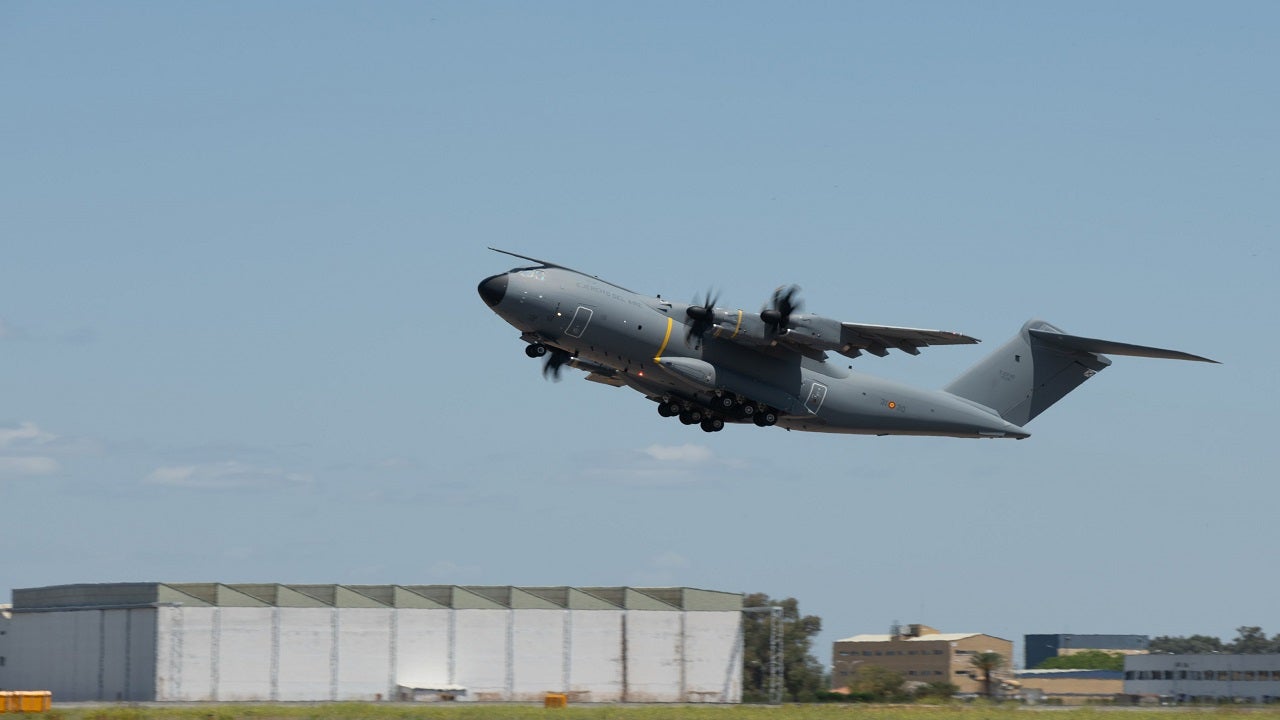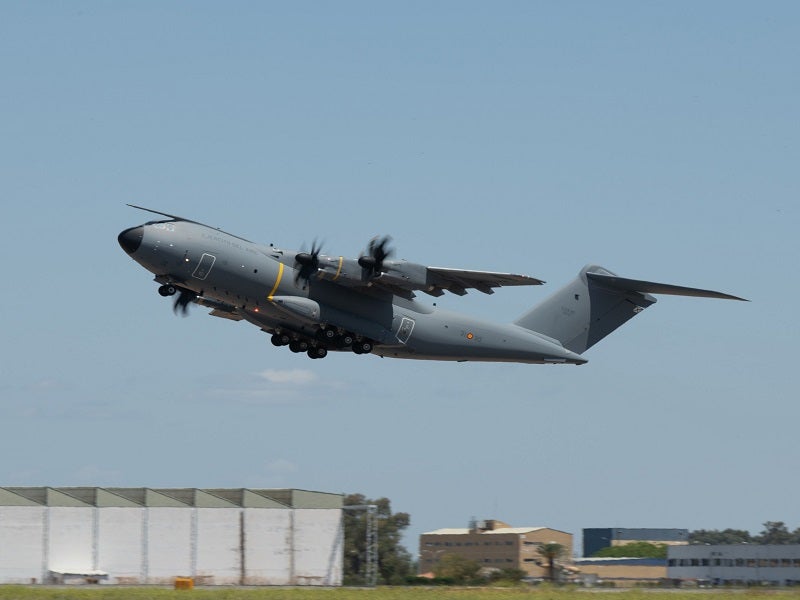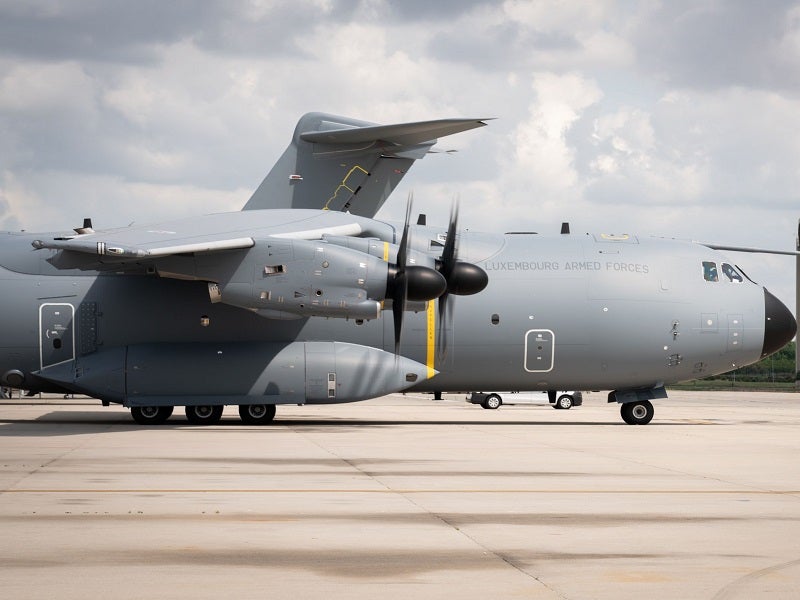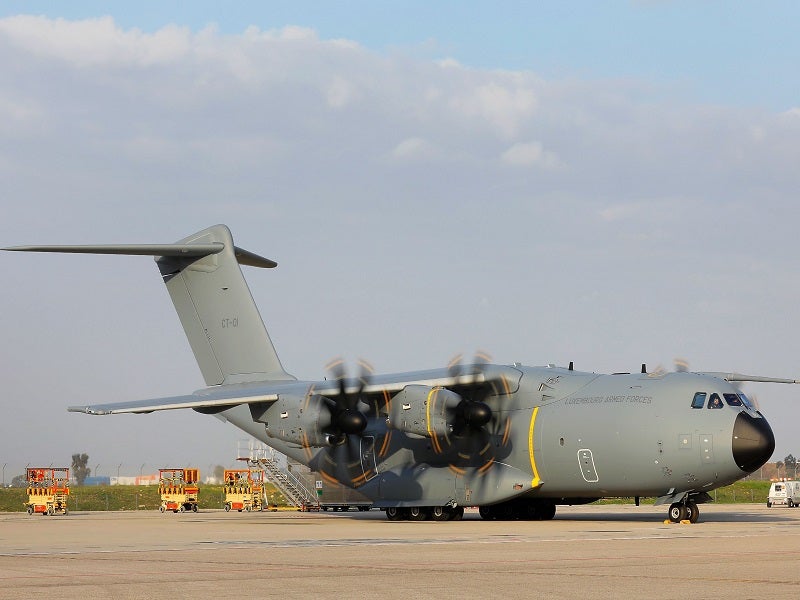The A400M (formerly known as the future large aircraft) is a military transporter designed to meet the requirements of the Belgium, French, German, Spanish, Turkish, Luxembourg and UK air forces.
The aircraft is manufactured by Airbus Defence and Space, a division of the European aerospace and defence firm Airbus.
Other companies with a share in the programme include BAE Systems (UK), EADS (Germany, France and Spain), Flabel (Belgium), and Tusas Aerospace Industries (Turkey).
A400M future large aircraft programme
A development and production contract was signed between Airbus and the European procurement agency OCCAR for 212 aircraft in May 2003. France, Germany, Italy, Spain, the UK, Turkey, Belgium, and Luxembourg initially signed it, but Italy subsequently withdrew. The order was consequently reduced to 180 aircraft, with deliveries starting in 2009.
The first metal cut for the airframe of the A400M took place in January 2005 and assembly began in 2007. The first flight was scheduled for early 2008; however, this was delayed due to engine development problems. The first A400M aircraft was officially rolled out in June 2008 and the long-awaited maiden flight took place on 11 December 2009.
The aircraft took off with 127t in weight, carrying 15t of test equipment, including 2t of water ballast. Its official maximum take-off weight is 141t.
In January 2009, EADS postponed the first deliveries of the A400M until 2012 and wanted to develop a new approach for the A400M to discover new ways to advance the programme.
2009 continued to be a troubled year for the A400M as estimates on the cost overrun of the project were released. The project was predicted to be up to €11.2bn over budget. The South African Air Force started to look at alternatives to the A400M and the European partners placed it under consideration. Airbus suggested that the programme may be scrapped unless €5.3bn could be provided.
Belgium, the UK, France, Germany, Luxembourg, Spain, and Turkey agreed to lend Airbus €1.5bn to proceed with the programme in November 2010; however, Germany and the UK reduced the number of aircraft ordered to 53 and 22 respectively, decreasing the total to 170.
The first deliveries were made to the French Air Force in August 2013, and the remaining deliveries are expected to conclude in 2025.
A400M test flights
Following the maiden flight of the first A400M, known as MSN1, the second A400M, MSN2, completed its maiden flight on 8 April 2010, while MSN3 completed its maiden flight on 9 July 2010. The fourth A400M MSN4 completed its maiden flight in December 2010. The first production aircraft of the A400M (MSN7) completed its maiden flight on 6 March 2013.
The development of the A400M fleet was designated as Grizzly in July 2010. Trials with the MSN1, MSN3, and MSN5 are performed in Toulouse while those with the MSN2 and MSN4 are carried out in Seville, providing greater flexibility and taking advantage of the best weather conditions available.
The A400M was displayed at two events in 2010: the Berlin Air Show in Germany, and the Farnborough International Air Show in the UK.
The A400M was tested on wet runways and taxiways in October 2011. The water ingestion test was completed successfully. The latest cold-weather tests were concluded in February 2013.
Airbus completed a certification testing of the A400M on grass runways in November 2015. The aircraft demonstrated its ability to land on the soft unpaved runway at Pembrey Sands Beach, UK, in May 2017.
An A400M refuelled six of the Spanish Air Force’s F 18 fighter jets in a single flight as part of an air-to-air refuelling human factors certification flight conducted in December 2017.
The airlifter successfully demonstrated its paratrooping deployment capability, with a maximum dispatch of 116 paratroopers using both side doors in a certification fight test, which was conducted in May 2020.
The aircraft reached a new milestone with the qualification of its automatic low-level flight capability, which provides a special class capability for military transport aircraft, in May 2020. This first qualification phase involves operations with visual meteorological conditions with visibility for the crew. The second phase certification includes the instrumental meteorological parameters, without visibility.
In collaboration with the Spanish Air Force test centre (CLAEX), Airbus successfully completed the certification flight tests for the A400M cargo hold tanks (CHT) refuelling unit in February 2019.
The French Armament General Directorate (DGA) and Airbus Defence and Space conducted an important helicopter refuelling certification campaign for the A400M in April 2021. The flight tests for the airlifter involved refuelling operations with two H225M helicopters from the French Air Force.
The tests were conducted during the day and night at altitudes ranging between 1,000ft (304.8m) and 10,000ft (3,048m), and speeds as low as 105kt. The aircraft achieved the objective of refuelling two helicopters simultaneously for the first time.
A400M orders and deliveries
The number of firm orders for the A400M stands at 174 aircraft. Malaysia ordered four, and 170 aircraft were ordered by seven countries, including the UK (22), Belgium (7), Turkey (10), France (50), Germany (53), Luxembourg (1) and Spain (27).
In April 2005, South Africa signed a contract with Airbus Military to be a full participant in the A400M programme. South Africa ordered eight aircraft to be delivered between 2010 and 2014. South Africa then cancelled the order in November 2009.
In December 2005, Malaysia signed a contract for the purchase of four A400M aircraft. Deliveries began in March 2015 and concluded in March 2017.
The Spanish Air Force received a delivery of its first A400M in December 2016. The French Air Force received its 14th A400M aircraft in March 2018. Germany received the delivery of its 18th A400M in March 2018.
The Airbus A400M airlifter ordered by the Luxembourgish Air Forces made its maiden flight in April 2020, marking a significant milestone in its development. The aircraft, named the MSN104, was delivered in October 2020.
A total of 90 A400M aircraft have been delivered as of April 2020. Airbus delivered the tenth A400M to the Spanish Air Force in May 2021, which marked the completion of 100 deliveries globally.
In June 2019, German Bundesamt für Ausrüstung, Informationstechnik und Nutzung der Bundeswehr (BAAINBw) signed a contract with Airbus Defence and Space for the integration and certification of a J-MUSIC directed infrared countermeasure (DIRCM) system inside the defensive aids sub-system (DASS) for the A400M aircraft of the German Air Force.
Airbus delivered the first aircraft to the Belgian Air Force in December 2020. Known as the MSN106, the aircraft is based at the 15th Wing Air Transport in Melsbroek, Belgium.
The Republic of Kazakhstan signed a contract with Airbus Defence for the delivery of two A400Ms in September 2021. The contract also includes maintenance and training support. The first aircraft is expected to be delivered in 2024.
A400M design
The A400M has a much larger payload than the C-160 Transall and C-130, and the design makes extensive use of composite materials. Its capability for short, soft field landing and take-off is part of the requirement and the aircraft has six-wheel high-flotation main landing gear.
Airdrops and tactical flight requires good low-airspeed flight, and the aircraft is also capable of long-range, high-cruise speeds for rapid and flexible deployment.
UK-based GKN Aerospace supplied the complex carbon composite wing spars. South Africa’s Denel Aviation supplied the fuselage top shells and wing-fuselage fairings and EADS provided the 7m x 4m composite cargo door.
Assembly of the fuselage shells takes place at Airbus Deutschland in Bremen, Germany. The final assembly of the A400M aircraft takes place at EADS CASA in Seville.
A400M cockpit and avionics
The A400M cockpit is fully night-vision compatible and provides accommodation for two pilots and an additional crew member for special mission equipment operations. It is fitted with a fly-by-wire flight control system developed for the Airbus range of civil airliners.
Two sidestick controllers are installed to provide the pilot with an unrestricted view of the electronic flight displays. The throttle controls are placed centrally between the two pilot stations.
Thales and Diehl Avionik Systeme developed the A400M’s FMS400 flight management system, based on integrated modular avionics modules.
The avionics includes cockpit control and display systems with nine 6in² displays and a digital head-up display, which features liquid crystal display (LCD) technology and enhanced vision systems (EVS), for improved situational awareness, automated CG calculation, automated defensive aids systems, simple EMCOM switching, simplified switching, uncluttered screens, automated tanker and receiver fuel control, and auto fuel tank inerting.
The A400M for the German Air Force is fitted with a terrain-masking low-level flight (TMLLF) system, from EADS Military Aircraft, for low-level flight control. The TMLLF system has a Saab Avitronics flight computer. EADS Defence & Security Systems digital map generator is also fitted.
The aircraft also has a military mission management system (MMMS), which includes two mission computers, from EADS Defence Electronics. The MMMS controls cargo handling and delivery, load plan calculations, and the computed air release point before an airdrop, as well as fuel management and fuel operational ranges. The MMMS also manages the tactical ground collision avoidance system (T-CGAS) and military/civil communications.
Rockwell Collins was selected to supply the HF-9500 high-frequency communications system and the avionics full-duplex ethernet (ADFX). Cobham Antennas Division provides the SATCOM antennas. The A400M is integrated with very high frequency (VHF)/ultra-high frequency (UHF) radio equipment from Rohde & Schwarz’s SOVERON family.
Countermeasure technology
The EADS Defence Electronics defensive aids suite includes an ALR-400 radar warner from Indra and EADS, a multicolour infrared alerting sensor (MIRAS), a missile launch and approach warner developed by EADS and Thales, and chaff and flare decoy dispensers. Diehl Defence is the supplier of the DE DIRCM system, which is based on Elbit Systems’ J-MUSIC DIRCM and will be integrated into the German A400M fleet. The company awarded a $73m contract to Elbit Systems to provide the J-MUSIC DIRCM in June 2019.
The aircraft can also accommodate armour plating crew protection, bulletproof windscreens, engine exhaust treatment for infrared emission reduction, and inert gas explosion retardation and fire retardation in the fuel systems. The wings have hardpoints for the installation of electronic warfare pods and refuelling pods.
A400M transporter cargo systems
Rheinmetall Defence Electronics is supplying the loadmaster control system for electronic cargo control. The loadmaster consists of a workstation and control panel, eight sidewall lock panels, and a crew door panel. It provides efficient ground loading and airborne cargo drops.
The payload requirements include a range of military helicopters and vehicles, heavy engineering equipment, pallets, and cargo containers. The maximum payload carrying capacity of the aircraft is 37t and its volume is 340m³ (12,000ft³).
The cargo bay can transport up to nine standard military pallets (2.23m x 2.74m), including two on the ramp, as well as 58 troops seated along the sides, or up to 120 fully equipped troops seated in four rows. For Medevac, it can carry up to 66 stretchers and 25 medical personnel.
The A400M can carry 116 paratroops and airdrop them and their equipment either by parachute or gravity extraction. It can air-drop single loads up to 16t, multiple loads up to 25t total,120 paratroops and a wedge load of 6t, or up to 20 1t containers or pallets.
It can also perform simultaneous drops of paratroops and cargo (RAS/wedge or door loads) and very-low-level extraction (VLLE) of a single load up to 6.35t, or multiple loads up to 19t in total. Gravity extraction can be performed for a single load up to 4t, or multiple loads up to 20tt.
The cargo compartment can be configured for cargo, vehicle or troop transport or airdrops, a combination of these, and for aero-medical evacuation. A single loadmaster can reconfigure the cargo compartment for different roles, either in flight or on the ground. A powered crane installed in the ceiling area of the rear section of the fuselage has a 5t capacity for loading from the ground and cross-loading.
The rear-opening door has a full compartment cross-section to allow axial load movement, roll-on and roll-off loading, and the airdropping of large loads. The autonomous ground operations of the aircraft reduce the time on the ground to minimise the risk of hostile action from enemy forces.
A400M tactical tanker and refuelling
The A400M can be converted into a tactical tanker that has the ability to refuel a range of aircraft and helicopters within two hours. Flight Refuelling is supplying the 908E wing pod drogue system, which provides a fuel flow of up to 1,200kg/min for each pod, plus the centreline pallet-mounted hose drum unit fitted in the rear cargo bay, which supplies a fuel flow of 1,800kg/min.
Up to two cargo bay fuel tanks (CBT), which connect directly to the A400M’s fuel management system, can be fitted. The total fuel capacity is 46.7t or 58t with the CBTs.
GKN Aerospace won a £6m ($9.54m) contract from Cobham Mission Equipment in October 2011. It includes supplying the air refuelling pylon for the A400M and supplying a wing spar for the A400M.
Navigation in the A400M
The aircraft’s independent navigation system comprises an inertial reference system (IRS) integrated with a global positioning system (GPS). The weather and navigation radar is the Northrop Grumman AN/APN-241E, which combines wind shear measurement and ground mapping capabilities.
The radio navigation suite includes a pair of instrument landing systems, VHF omnidirectional radio ranging (VOR), radio distance measuring equipment (DME), air traffic control (ATC) transponders, automatic direction finders (ADF), and a tactical air navigation unit (TACAN).
Engines onboard the A400M
Airbus Military selected the three-shaft TP400-D6 turboprop engine manufactured by EuroProp International (EPI) in May 2003. EPI is a consortium formed by Rolls-Royce (UK, Germany), ITP (Spain), MTU (Germany) and Snecma (France). Rolls-Royce is responsible for the overall integration.
Each of the four engines has a maximum output of more than 11,000shp. EPI states that they are the largest turboprops ever made in the West. The engines are fitted with FADEC (full authority digital engine control), supplied by BAE Systems and Hispano-Suiza.
The turboprop arrangement has two turbofans on either side of the fuselage. The counter-rotation of the fans creates a symmetrical airflow over the wing to improve the lift capacity, handling, and stability. Additionally, it reduces the structural weight of the wing and minimises the adverse yaw in the event of an engine failure.
French firm Ratier-Figeac, a business unit of US-based Hamilton Standard, supplies the eight-bladed composite variable pitch FH386 propellers. The propellers are 5.33m (17.5ft) in diameter and can reverse and support the fully loaded aircraft up a slope. FiatAvio supplies the propeller gearbox. Electrical power generation systems are supplied by Aerolec, a joint venture between Thales and Goodrich. The variable frequency generators provide up to 400kVa.
Landing gear on the A400M
Messier-Dowty was chosen as the supplier of both the main and nose landing gear. Each main landing gear consists of three independent twin-wheel assemblies, providing six wheels on each side. This allows the plane to land on unprepared runways. The landing gear system also enables the A400M to ‘kneel’, which lowers the rear ramp to enable the loading of large vehicles.
The main landing gear shock absorbers maintain a minimum distance from the ground. The aircraft has two nose wheels and 12 braked wheels supplied by Messier-Bugatti.
The power plant is installed on the inner engine mount of the C-130K flight test-bed.
The A400M’s normal operating speed is 555km/h, but it can reach a maximum speed of 780km/h. The normal and ferry ranges of the aircraft are 3,298km and 8,710km respectively. The service ceiling is 11,300m.
The take-off and landing distances of the aircraft are 980m and 770m respectively. The aircraft weighs approximately 76,500kg and the maximum take-off weight is 141,000kg.











